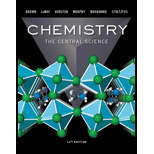
(a)
To determine: The test of the given hypothesis on the alkali metals; also the factors favoring the superoxide formation.
(a)
Answer to Problem 1DE
Solution: The oxidation of rubidium and cesium in presence of air forms superoxide. The bigger size of cation is a favorable factor for superoxide formation.
Explanation of Solution
The alkali metals such as rubidium and cesium which has lower first ionization energies can be used to test the given hypothesis. The larger size of cation results in the easy removal of electron due to which ionization energy of the atom decreases. Therefore, the oxidation of rubidium and cesium metal in presence of oxygen results in the formation of superoxide which confirms the statement that the lower ionization energy favors the superoxide formation.
The larger size cation can accommodate the larger size anion around it. Therefore, the bigger size of cation is a property which favors the superoxide formation.
The oxidation of rubidium and cesium in presence of air forms superoxide. The bigger size of cation is a favorable factor for superoxide formation.
(b)
To determine: The experiment to determine the potassium peroxide reacts with
(b)
Answer to Problem 1DE
Solution: The color of potassium superoxide salt changes from light yellow to white on reaction with water and carbon dioxide. The products of the reaction with water is
Explanation of Solution
The potassium superoxide is a yellow color salt. The reaction of potassium superoxide with water results in the change of its color from yellow to white. In the same way the potassium superoxide changes its color instaneously on coming in contact with water. This experiment confirms that the potassium superoxide reacts with carbon dioxide and water.
The reaction of potassium superoxide with water is given as,
The reaction of potassium superoxide with carbon dioxide is given as,
The color of potassium superoxide salt changes from light yellow to white on reaction with water and carbon dioxide. The products of the reaction with water is
(c)
To determine: The experiment to determine the reaction given in part (b) important in the firefighters breathing masks or not.
(c)
Answer to Problem 1DE
Solution: The green canister present in the breathing apparatus contains potassium superoxide as oxygen generator.
Explanation of Solution
The firefighter breathing apparatus contains a green canister which contains the chemicals which are used in the breathing apparatus. This is present at the base of the breathing device, The oxygen generated by the green canister is done by using potassium superoxide present in the green canister. This confirms that the reaction given in part (b) is important in the firefighters breathing apparatus.
The green canister present in the breathing apparatus contains potassium superoxide as oxygen generator.
(d)
To determine: The experiment to determine the percentages of
(d)
Answer to Problem 1DE
Solution: The reaction of
Explanation of Solution
The potassium superoxide on removal of oxygen at
The above reaction is still goes on heating will gives the formation of
After determining the mass of
The reaction of
Want to see more full solutions like this?
Chapter 7 Solutions
Chemistry: The Central Science Plus Mastering Chemistry with Pearson eText -- Access Card Package (14th Edition)
- Synthesize 2-Ethyl-3-methyloxirane from dimethyl(propyl)sulfonium iodide using the necessary organic or inorganic reagents. Draw the structures of the compounds.arrow_forwardSynthesize 2-Hydroxy-2-phenylacetonitrile from phenylmethanol using the necessary organic or inorganic reagents. Draw the structures of the compounds.arrow_forwardSynthesize N-Methylcyclohexylamine from cyclohexanol using the necessary organic or inorganic reagents. Draw the structures of the compounds.arrow_forward
- Synthesize N-Methylcyclohexylamine from cyclohexanol using the necessary organic or inorganic reagents. Draw the structures of the compounds.arrow_forwardIf possible, please provide the formula of the compound 3,3-dimethylbut-2-enal.arrow_forwardSynthesize 1,4-dibromobenzene from acetanilide (N-phenylacetamide) using the necessary organic or inorganic reagents. Draw the structures of the compounds.arrow_forward
- Indicate the products obtained by mixing (3-oxo-3-phenylpropyl)triphenylphosphonium bromide with sodium hydride.arrow_forwardWe mix N-ethyl-2-hexanamine with excess methyl iodide and followed by heating with aqueous Ag2O. Indicate the major products obtained.arrow_forwardIndicate the products obtained by mixing acetophenone with iodine and NaOH.arrow_forward
- Indicate the products obtained by mixing 2-Propanone and ethyllithium and performing a subsequent acid hydrolysis.arrow_forwardIndicate the products obtained if (E)-2-butenal and 3-oxo-butanenitrile are mixed with sodium ethoxide in ethanol.arrow_forwardQuestion 3 (4 points), Draw a full arrow-pushing mechanism for the following reaction Please draw all structures clearly. Note that this intramolecular cyclization is analogous to the mechanism for halohydrin formation. COH Br + HBr Brarrow_forward
 ChemistryChemistryISBN:9781305957404Author:Steven S. Zumdahl, Susan A. Zumdahl, Donald J. DeCostePublisher:Cengage Learning
ChemistryChemistryISBN:9781305957404Author:Steven S. Zumdahl, Susan A. Zumdahl, Donald J. DeCostePublisher:Cengage Learning ChemistryChemistryISBN:9781259911156Author:Raymond Chang Dr., Jason Overby ProfessorPublisher:McGraw-Hill Education
ChemistryChemistryISBN:9781259911156Author:Raymond Chang Dr., Jason Overby ProfessorPublisher:McGraw-Hill Education Principles of Instrumental AnalysisChemistryISBN:9781305577213Author:Douglas A. Skoog, F. James Holler, Stanley R. CrouchPublisher:Cengage Learning
Principles of Instrumental AnalysisChemistryISBN:9781305577213Author:Douglas A. Skoog, F. James Holler, Stanley R. CrouchPublisher:Cengage Learning Organic ChemistryChemistryISBN:9780078021558Author:Janice Gorzynski Smith Dr.Publisher:McGraw-Hill Education
Organic ChemistryChemistryISBN:9780078021558Author:Janice Gorzynski Smith Dr.Publisher:McGraw-Hill Education Chemistry: Principles and ReactionsChemistryISBN:9781305079373Author:William L. Masterton, Cecile N. HurleyPublisher:Cengage Learning
Chemistry: Principles and ReactionsChemistryISBN:9781305079373Author:William L. Masterton, Cecile N. HurleyPublisher:Cengage Learning Elementary Principles of Chemical Processes, Bind...ChemistryISBN:9781118431221Author:Richard M. Felder, Ronald W. Rousseau, Lisa G. BullardPublisher:WILEY
Elementary Principles of Chemical Processes, Bind...ChemistryISBN:9781118431221Author:Richard M. Felder, Ronald W. Rousseau, Lisa G. BullardPublisher:WILEY





